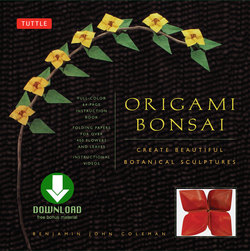Читать книгу Origami Bonsai - Benjamin John Coleman - Страница 8
На сайте Литреса книга снята с продажи.
ОглавлениеPreparing Paper for Folding
When Tuttle Publishing asked me to design a set of origami papers I got excited. I’ve wanted to design papers for flowers and leaves for a long time, and here was an opportunity to do it! I faced a number of challenges and I thought about the designs for a long time. After a period of reflection, I decided to emphasize color relationships.
Upon initial inspection you’ll notice that the papers have similar patterns, with different colors. The dominant colors tend to be people’s favorites. They invite people in for a closer look. The accent colors are different, each one complementing the dominant color in a different way. For example, the aquamarine blue paper has a green accent, whereas the dark blue paper has an almost black accent. Once folded into a flower, you will see that these colors—along with the geometric pattern—have been specifically chosen and blended to create a sense of complexity when people look closely at your models. I’ve also added a subtle grain to all of the patterns to achieve more natural, composite tones.
I encountered several challenges when designing the papers. Limitations were imposed due to the printing process. In order to offer maximum benefit, I opted to supply 48 eight-inch squares, and then print patterns for four large, or 16 small flowers on each square. That means you’re going to have to cut the squares. Squares with large patterns on them get cut into quarters. Squares with small patterns printed on them get cut into sixteenths.
Before you decide that this is a non-traditional approach, consider that every square is cut as part of its manufacture. Even paper made at home requires cutting to obtain a square. And because you’re cutting the squares, I’ve been able to include enough paper to make 448 flowers! This kit also contains enough leaf-colored paper to make about 128 large leaves, which is enough for four to six sculptures. (Download HERE.)
I decided to include more paper for flowers than for leaves because I felt that’s what folders would enjoy most. This decision allowed me to increase the variety, giving you more color choices. Flowers make people smile. I like giving them away, and I’m sure you’ll find many uses for the extra flower paper that’s been included.
Both the geometric pattern and the color of the highlights are designed to maximize the visual complexity of the folded flower.
Notice how the highlight on the blue flower creates the illusion of a reflection from the yellow flower.
Cut along the dashed lines to prepare the individual squares for folding.
Cutting Squares for Leaves
Perform the first eight steps of the Black Eyed Susan (page 28) to create a grid of horizontal and vertical folds.
Cut along each horizontal and vertical fold (not the diagonals!) to create 16 squares for leaves.
